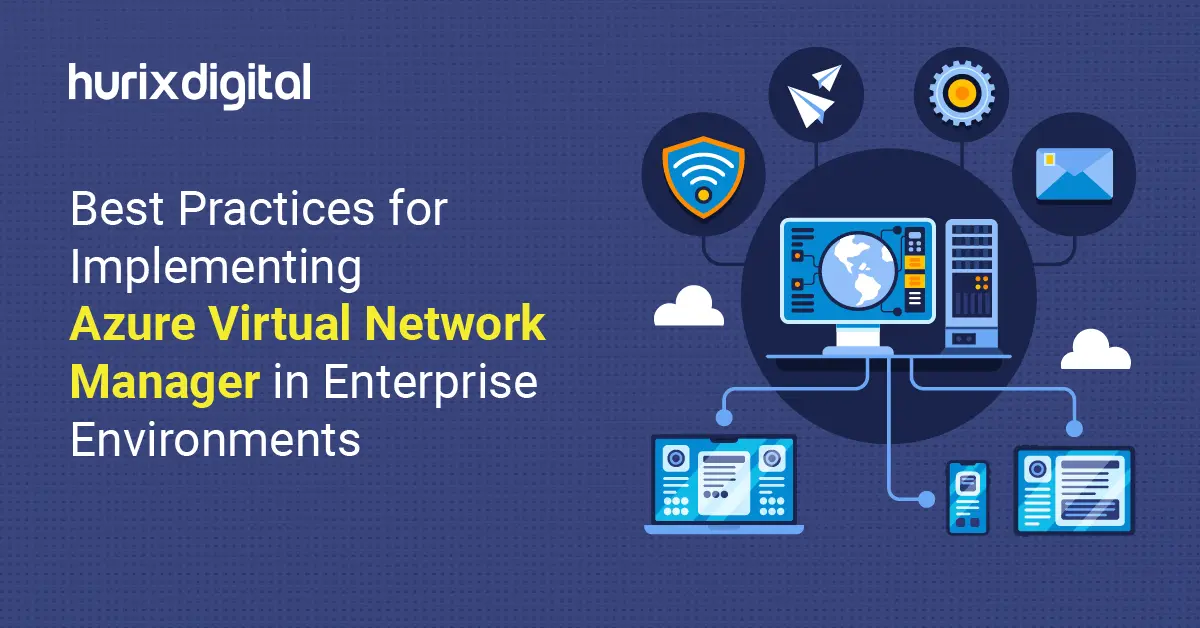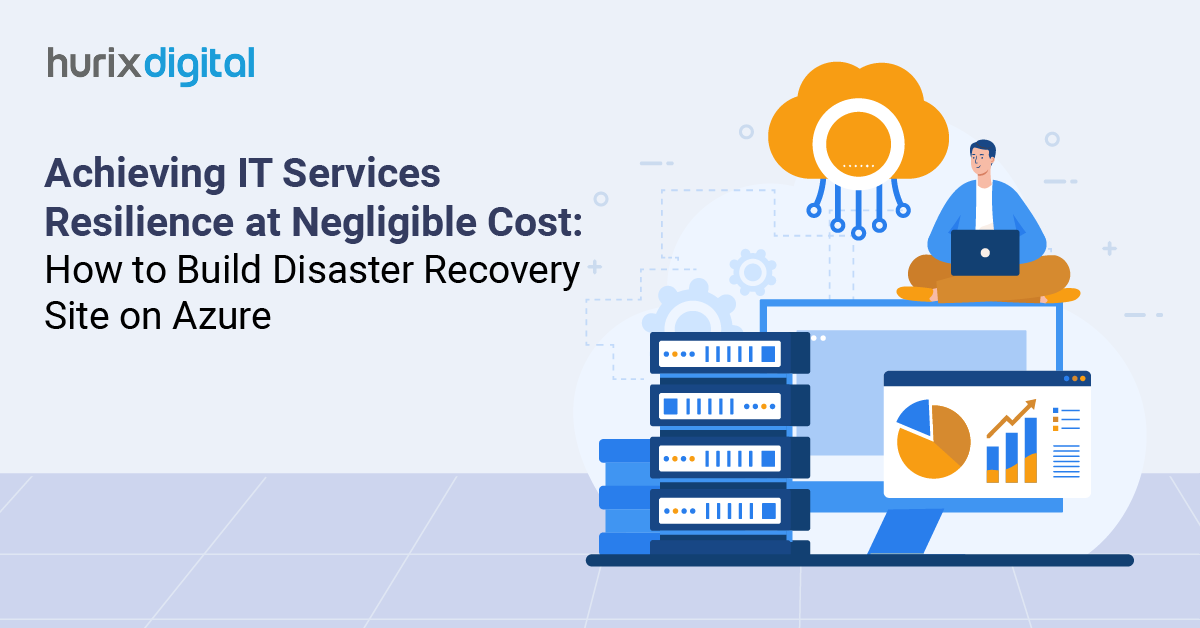
Best Practices for Implementing Azure Virtual Network Manager in Enterprise Environments
Summarize with:
In today’s fast-changing IT enterprise landscape maintaining secure, scalable, and efficient network infrastructures is most crucial. As organizations are making their transition from on-premise to cloud-based solutions the complexity of managing the virtual networks is also growing. To break this complexity Azure Virtual Network Manager (AVNM) offers a powerful solution to these challenges, providing enterprises with a centralized tool to manage and optimize their Azure virtual networks.
Azure Virtual Network Manager delivers a robust set of features that simplify network management tasks, enforce security policies, and ensure consistent network configurations across multiple virtual networks and regions. By integrating seamlessly with other Azure services, AVNM enables IT administrators to efficiently handle network connectivity, security, and compliance requirements.
Successfully implementing AVNM in an enterprise environment requires adherence to best practices that maximize its potential. Following these guidelines helps organizations build a resilient network infrastructure that supports business goals while maintaining high standards of security and compliance.
This introduction highlights the importance of Azure Virtual Network Manager and sets the stage for an in-depth discussion on best practices for implementing it in enterprise environments.
Table of Contents:
- What is Azure Virtual Network Manager?
- How Does Azure Virtual Network Manager Work?
- Best Practices for Implementing Azure Virtual Network Manager.
- Key Benefits of Using AVNM
- Conclusion
What is Azure Virtual Network Manager?
Azure Virtual Network Manager is a comprehensive management service designed to streamline the grouping, configuration, deployment, and administration of virtual networks across multiple subscriptions globally. It allows you to create network groups, which facilitate the logical segmentation and identification of your virtual networks. By defining these groups, you can efficiently determine and implement connectivity and security configurations, applying them consistently across all selected virtual networks within the groups.
Also Read: Navigating Cloud Governance and Compliance: Strategies for Regulatory Success
How Does Azure Virtual Network Manager Work?
When setting up Azure Virtual Network Manager, you first define its management scope, which limits its configuration capabilities to within this specified boundary. This scope can be set directly on a list of subscriptions, but it is advisable to use management groups for better hierarchical organization. Once the scope is defined, you can deploy various configuration types, such as Connectivity and Security Admin rules.
After deploying the Virtual Network Manager instance, the next step is to create a network group—a logical container for networking resources where configurations are applied at scale. You can add virtual networks to this group either manually (static membership) or by using Azure Policy to dynamically govern membership based on defined conditions (dynamic membership). For details on Azure Policy initiatives, refer to Azure Virtual Network Manager and Azure Policy.
Following the creation of network groups, you configure connectivity and/or security settings based on your network topology and security requirements. Connectivity configurations allow you to set up network topologies like mesh or hub-and-spoke, while security configurations enable you to apply rules across network groups at a global level. Once configured, you can deploy these settings to any chosen region.
Best Practices for Implementing Azure Virtual Network Manager.
In the modern enterprise landscape, managing network infrastructure efficiently is paramount. Azure Virtual Network Manager (AVNM) offers a comprehensive solution to streamline and centralize the management of virtual networks across multiple subscriptions and regions. Here are some best practices to ensure a successful implementation of AVNM in your enterprise environment.
1. Define Clear Network Segmentation
Start by defining clear network segmentation to logically group your virtual networks. Use network groups to segment networks based on environments, teams, locations, or business functions. This logical grouping simplifies the application of connectivity and security configurations across multiple virtual networks.
2. Utilize Management Groups for Scope Definition
When defining the scope for AVNM, leverage management groups to organize your subscriptions hierarchically. This approach provides a structured way to apply configurations and manage access controls efficiently. Management groups allow you to apply policies and role-based access controls (RBAC) at a higher level, ensuring consistency across your organization.
3. Implement Consistent Security Policies
AVNM allows you to create and enforce security policies centrally. Define security administrator rules that override network security group (NSG) rules to ensure consistent security across your network. This centralized approach helps in maintaining a robust security posture, reducing the risk of misconfigurations and ensuring compliance with organizational security standards.
4. Adopt a Scalable Network Topology
Choose a network topology that aligns with your business requirements. AVNM supports both hub-and-spoke and mesh topologies. For most enterprise environments, a hub-and-spoke topology with direct connectivity between spokes is recommended for its scalability and ease of management. This topology allows for efficient traffic flow and centralized security management.
5. Automate Network Configuration Management
Leverage automation tools like Azure Policy, Azure CLI, Azure PowerShell, or Terraform to manage network configurations at scale. Automation reduces the risk of human error and ensures that configurations are applied consistently across your environment. Implementing Infrastructure as Code (IaC) practices can further enhance the reliability and repeatability of your network configurations.
6. Monitor and Optimize Network Performance
Regularly monitor network performance and optimize configurations as needed. Use Azure Monitor and Network Watcher to gain insights into network traffic, identify bottlenecks, and ensure optimal performance. Proactive monitoring helps in detecting and resolving issues before they impact business operations.
7. Stay Within Defined Limits
Adhere to the defined limits of AVNM to avoid performance issues. Regularly review and update your network configurations to stay within these limits and ensure smooth operation. Understanding the service limits and planning your network architecture accordingly can prevent unexpected disruptions.
Key Benefits of Using AVNM
- Centralized Management: Oversee connectivity and security policies globally, spanning multiple regions and subscriptions from a single point of control.
- Simplified Connectivity: Facilitate direct communication between spokes in a hub-and-spoke setup, avoiding the complexities of managing a mesh network.
- Scalability and Availability: Benefit from a highly scalable and available service, featuring global redundancy and replication to ensure consistent performance.
- Enhanced Security: Create network security rules that can supersede those set by network security groups, providing greater control over network security.
- Optimized Performance: Achieve low latency and high bandwidth between resources in different virtual networks through virtual network peering.
- Controlled Deployment: Implement network changes according to a predefined regional sequence and frequency, tailoring updates to your specific needs.
Also Read: 12 Emerging Trends in Cloud Managed Services: Predictions for 2025
Conclusion
Azure Virtual Network Manager (AVNM) stands out as a powerful tool for effectively managing complex network environments in today’s rapidly evolving IT landscape. By centralizing the management of connectivity and security policies, AVNM simplifies the administration of virtual networks across diverse subscriptions and regions. Its seamless integration with other Azure services enhances scalability, performance, and security.
To fully leverage AVNM’s capabilities, it’s crucial to follow best practices such as clear network segmentation, hierarchical organization with management groups, and consistent security policy enforcement. Adopting scalable network topologies and utilizing automation tools for configuration management will further optimize performance and reduce errors. Overall, Azure Virtual Network Manager enables organizations to create and maintain a robust, secure, and efficient network infrastructure that aligns with their strategic objectives and adapts to technological advancements.
Our experts at Hurix Digital for Cloud Security Services will discuss your specific security needs. Our expert will provide detailed guidance and solutions, from initial consultation to ongoing support and optimization, to help you strengthen your security posture and mitigate cyber risks effectively.
Schedule a quick call to learn more!
Summarize with:

Network Consultant- Cloud Services
Akshay is an experienced Network & Security Consultant with strong knowledge of cloud networking and on-premise networks. He is a Certified Microsoft professional to set up customers’ expected Infrastructure on the Cloud meeting compliance standards. He has good hands-on on cloud product versions of Palo Alto, CheckPoint, Fortigate etc.
 A Space for Thoughtful
A Space for Thoughtful 



